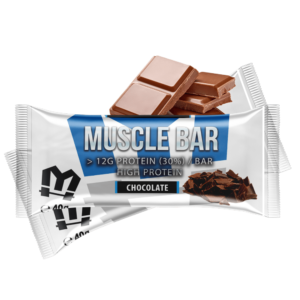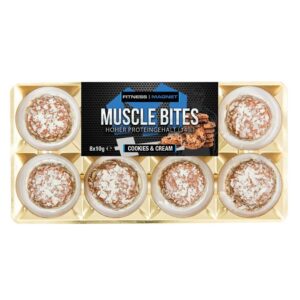An jedem Montag bietet sich beim Betreten des Fitnessstudios das gleiche Bild – gähnende Leere im Cardiobereich, keine Menschenseele am Beinstrecker und auch die Power Racks sind verweist. Im Gegenzug umkreisen ganze Heerscharen von Athleten wie kleine fleißige Bienchen die Bänke im Freihantelbereich, denn Montag ist Brusttag. Damit du nicht der Nächste bist, der munter um die Drückerbank herumkreiselt, sondern stets eine Alternative im Köcher hast, stellen wir dir fünf effektive Übungen für dein Brusttraining vor.
1. Bankdrücken
Gut, ganz ohne Bankdrücken kommen wir dann doch nicht aus, denn eines steht nun einmal unumstößlich fest – Bankdrücken ist die Abstand effektivste Übung für die Brust und trainiert darüber hinaus aufgrund ihrer Eigenschaft als Mehrgelenksübung weitere bedeutende Muskelgruppen wie die Schulter und den Trizeps. Wann immer du an einem Montag also eine freie Drückerbank erwischen solltest, ist es anzuraten diese Gelegenheit nicht verstreichen zu lassen. Aufgrund seiner Komplexität ist das Bankdrücken eine der Königsdisziplinen des Kraftsports und dementsprechend aus technischer Hinsicht sehr anfällig für Fehler. Zu Beginn legst du dich flach auf die Bank, stellst die Füße auf den Boden und positionierst deine Augen in Höhe der Hantelstange. Diese greifst du etwas mehr als schulterbreit, atmest ein, hebst das Gewicht heraus und senkst es langsam zum Brustbein hin ab. Anschließend bewegst du die Hantel in einem leichten Bogen wieder nach oben, um einen für die Schulter natürlichen Bewegungsablauf zu erzeugen. Insgesamt ist darauf zu achten, dass sich die Arme etwa im 45°-Winkel zum Oberkörper befinden, sodass die Brust optimal arbeiten kann und die Schulter nicht überlastet wird.
2. Schrägbankdrücken mit der Kurzhantel
Ähnlich wie der große Bruder mit der Langhantel, gestaltet sich auch die Ausführung des Kurzhantel-Bankdrückens technisch anspruchsvoll. Der Unterschied liegt jedoch darin, dass aufgrund der Verwendung von Kurzhanteln deutlich mehr Koordination gefragt ist, um die Übung sauber und sicher auszuführen. Weiterhin verschiebt sich mit zunehmendem Winkel der Bank die Belastung von der Brust zur Schulter, weshalb dieser nicht zu steil eingestellt werden sollte. Um den oberen Anteil der Brust, auf den das Schrägbankdrücken primär abzielt, optimal zu belasten, empfiehlt sich ein Anstellwinkel von 20° bis maximal 40°. Bei 45° und mehr verkommt das Brusttraining in erster Linie zum Schultertraining, was nicht der Sinn der Sache ist. Somit gilt es ebenso zu beachten, die Oberarme im 45°-Winkel zum Körper zu positionieren, um das Schultergelenk zu entlasten und den Fokus auf die Brust zu legen. Wichtig ist ebenfalls, dass du den vollen Bewegungsradius ausnutzt, die deine Schulter dir bietet, ohne diese allerdings zu überdehnen, was im Zuge der Verwendung eines zu schweren Gewichtes durchaus passieren kann. Wie immer ist also auch hier ein Gewicht zu wählen, das 8 bis 12 Mal sauber bewegt werden kann.
3. Negativbankdrücken
Das Negativbankdrücken ist im Bezug auf das Brusttraining das Pendant zum Schrägbankdrücken, da in diesem Fall der Fokus auf die Belastung des unteren Bereichs der Brust gelegt wird. Wie schon das Flachbank- und das Schrägbankdrücken, lässt sich auch diese Übung sowohl mit Kurzhanteln als auch mit der Langhantel durchführen, sodass sich das Brusttraining in jedem Fall abwechslungsreich gestalten lässt. Im Grunde genommen ähnelt die Ausführung des Negativbankdrückens der des Flachbandrückens, wobei allerdings darauf zu achten ist, dass diese Übung aufgrund der ungewohnten Liegeposition zunächst mit leichtem Gewicht erlernt werden sollte. Wichtig ist in dieser Hinsicht vor allem das Absenken der Stange, das deutlich kontrollierter vonstattengehen muss, damit das Gewicht nicht im Bereich des Halses zum Liegen kommt. Dementsprechend führst du die Stange langsam herunter und setzt diese auf die Mitte des Brustbeins, um einen möglichst günstigen Winkel für das Hochdrücken zu erhalten.
4. Fliegende mit der Kurzhantel
Im Gegensatz zu den Variationen des Bandrückens, an deren Durchführung stets mehrere Muskelgruppen beteiligt sind, handelt es sich bei den sogenannten Fliegenden mit der Kurzhantel um eine Isolationsübung, die sich einzig und alleine auf die Brust fokussiert. Zur Durchführung legst du dich flach mit dem Rücken auf eine Bank und streckst die Arme nach oben, sodass die Hanteln parallel zueinanderstehen. Anschließend senkst du die Arme langsam zur Seite ab bis deine Brust maximal gedehnt ist, und führst sie danach wieder langsam nach oben in die Ausgangsposition. Wichtig ist vor allem, dass du während der gesamten Bewegung einen leichten Winkel zwischen Oberarm und Unterarm hältst, um das Schultergelenk zu schonen. Darüber hinaus ist es essenziell, dass diese Übung besonders langsam, kontrolliert und ohne Schwung ausgeführt wird, denn in diesem Zusammenhang geht es nicht primär um das bewegte Gewicht sondern um das Muskelgefühl. Weiterhin empfiehlt es sich die Hanteln während der positiven Bewegungsphase leicht nach innen einzudrehen, um eine gesonderte Kontraktion des Muskelursprungs am Brustbein zu erreichen, diesen somit gezielt zu belasten und dadurch das Brusttraining effektiver zu gestalten.
5. Überzüge mit der Kurzhantel
Zwar werden die Überzüge mit der Kurzhantel von vielen Trainierenden oft unterschätzt und dementsprechend beim Brusttraining etwas stiefmütterlich behandelt, doch richtig ausgeführt können sie dein Brusttraining enorm bereichern, da sie neben dem großen Brustmuskel (M.pectoralis major) auch den vorderen Sägemuskel (M.serratus anterior), gezielt belasten. Um die Übung sauber ohne Trainingspartner ausführen zu können, positionierst du eine Kurzhantel aufrecht am Kopfende einer Flachbank, sodass du dein Trainingsgewicht darauf abstellen kannst. Nun legst du dich flach auf die Bank, stellst die Füße auf den Boden, greifst mit beiden Armen nach deinem Trainingsgewicht und hebst es an. Bei der Ausführung solltest du drauf achten, dass das Ellenbogengelenk lediglich einen leichten Winkel aufweist, um das Nachdrücken mit dem Trizeps zu verhindern, wodurch die Belastung nicht mehr hauptsächlich auf dem großen Brustmuskel und dem Sägemuskel liegt.
Abwechslung schafft mehr Spaß am Brusttraining
Das A und O beim Brusttraining ist neben der Effektivität der gewählten Übungen zweifelsfrei der Spaß sowie die damit verbundene Motivation als ausschlaggebender Erfolgsfaktor. Dementsprechend ist es wichtig Übungen punktuell auszutauschen und somit nicht nur für neue Reize, sondern auch für Abwechslung zu sorgen, was insbesondere dann hilfreich sein kann, wenn die erzielte Leistung stagniert. Die Grundkomponente für das Brusttraining ist in jedem Fall die Durchführung von ein bis zwei komplexen Druckübungen, da nur diese in der Lage sind die Zielmuskulatur funktionsgerecht auszubelasten. Isolationsübungen wie Fliegende und Überzüge folgen auf die Grundübungen, um die Brust noch einmal gezielt zu belasten und das Brusttraining damit so effektiv wie möglich zu gestalten.


